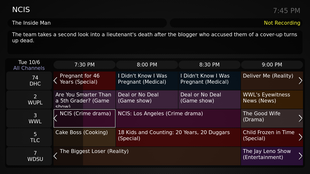Our website is made possible by displaying online advertisements to our visitors.
Please consider supporting us by disabling your ad blocker.
Television channel
This article has multiple issues. Please help improve it or discuss these issues on the talk page. (Learn how and when to remove these messages)
|

A television channel, or TV channel, is a terrestrial frequency or virtual number over which a television station or television network is distributed. For example, in North America, channel 2 refers to the terrestrial or cable band of 54 to 60 MHz, with carrier frequencies of 55.25 MHz for NTSC analog video (VSB) and 59.75 MHz for analog audio (FM), or 55.31 MHz for digital ATSC (8VSB). Channels may be shared by many different television stations or cable-distributed channels depending on the location and service provider
Depending on the multinational bandplan for a given region, analog television channels are typically 6, 7, or 8 MHz in bandwidth, and therefore television channel frequencies vary as well. Channel numbering is also different. Digital terrestrial television channels are the same as their analog predecessors for legacy reasons, however through multiplexing, each physical radio frequency (RF) channel can carry several digital subchannels. On satellites, each transponder normally carries one channel, however multiple small, independent channels can be on one transponder, with some loss of bandwidth due to the need for guard bands between unrelated transmissions. ISDB, used in Japan and Brazil, has a similar segmented mode.
Preventing interference between terrestrial channels in the same area is accomplished by skipping at least one channel between two analog stations' frequency allocations. Where channel numbers are sequential, frequencies are not contiguous, such as channel 6 to 7 skip from VHF low to high band, and channel 13 to 14 jump to UHF. On cable TV, it is possible to use adjacent channels only because they are all at the same power, something which could only be done terrestrially if the two stations were transmitted at the same power and height from the same location. For DTT, selectivity is inherently better, therefore channels adjacent (either to analog or digital stations) can be used even in the same area.
Previous Page Next Page


